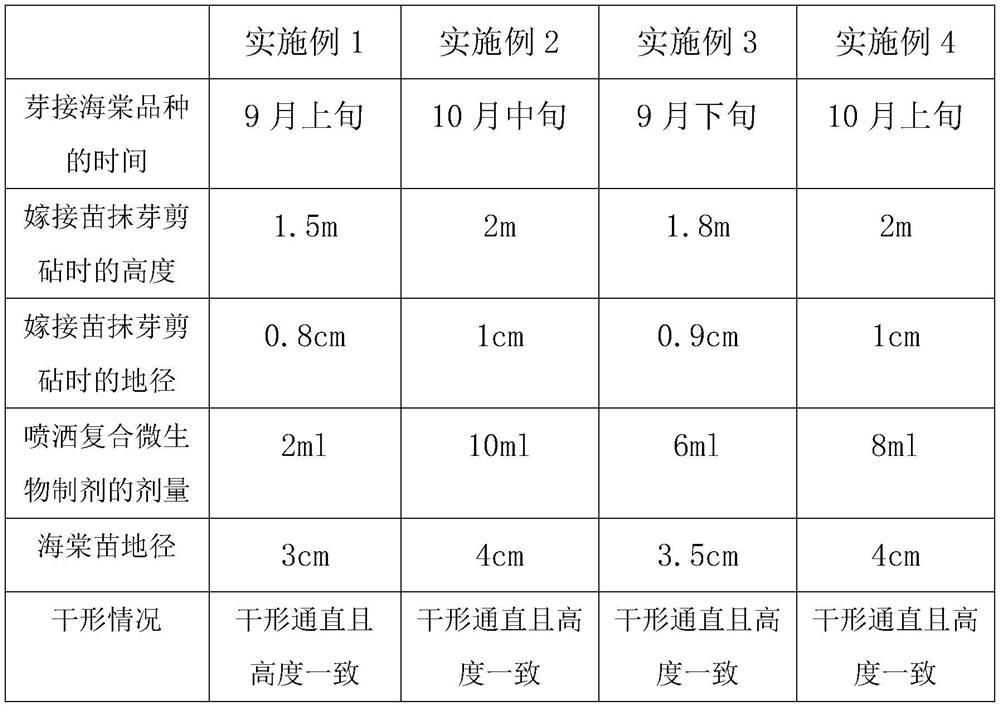Seedling cultivation method for forestry ornamental trees
A cultivation method and tree technology, which is applied in the field of seedling cultivation of ornamental trees in forestry, can solve the problems of weak trunk of young seedlings, high cost, and bent stem shape, etc.
- Summary
- Abstract
- Description
- Claims
- Application Information
AI Technical Summary
Problems solved by technology
Method used
Image
Examples
Embodiment 1
[0029] A method for cultivating seedlings of forestry ornamental trees, which adopts the following steps:
[0030] S1, in the first ten days of September of the first year, budding the cultivated crabapple varieties to obtain grafted seedlings;
[0031] S2, in the spring of the second year, the grafted seedlings are planted in the field;
[0032] S3, pay attention to observation after the sprouting of grafted seedlings, wipe the buds and cut the anvils in time, and carry out post-management at the same time;
[0033] S4, the grafted seedlings are transplanted in the third year, then determine the diameter of the bottom soil ball according to the dry diameter of the grafted seedlings, then water and soak in the scope of the soil ball diameter, to facilitate transplanting;
[0034] S5, when transplanting for long-distance transportation, carry out moisturizing treatment on the roots of the grafted seedlings, after transporting to the designated place, set the stem according to ...
Embodiment 2
[0050] A method for cultivating seedlings of forestry ornamental trees, which adopts the following steps:
[0051] S1, in mid-October of the first year, the cultivated crabapple varieties were bud grafted to obtain grafted seedlings;
[0052] S2, in the spring of the second year, the grafted seedlings are planted in the field;
[0053] S3, pay attention to observation after the sprouting of grafted seedlings, wipe the buds and cut the anvils in time, and carry out post-management at the same time;
[0054] S4, the grafted seedlings are transplanted in the third year, then determine the diameter of the soil ball at the bottom according to the dry diameter of the grafted seedlings, then water and soak in the scope of the soil ball diameter, so as to facilitate transplanting;
[0055] S5, when transplanting for long-distance transportation, carry out moisturizing treatment on the roots of the grafted seedlings, after transporting to the designated place, set the stem according to ...
Embodiment 3
[0071] A method for cultivating seedlings of forestry ornamental trees, which adopts the following steps:
[0072] S1, at the end of September of the first year, budding the cultivated crabapple varieties to obtain grafted seedlings;
[0073] S2, in the spring of the second year, the grafted seedlings are planted in the field;
[0074] S3, pay attention to observation after the sprouting of grafted seedlings, wipe the buds and cut the anvils in time, and carry out post-management at the same time;
[0075] S4, the grafted seedlings are transplanted in the third year, then determine the diameter of the bottom soil ball according to the dry diameter of the grafted seedlings, then water and soak in the scope of the soil ball diameter, to facilitate transplanting;
[0076] S5, when transplanting for long-distance transportation, carry out moisturizing treatment on the roots of the grafted seedlings, after transporting to the designated place, set the stem according to the cultiva...
PUM
| Property | Measurement | Unit |
|---|---|---|
| Height | aaaaa | aaaaa |
Abstract
Description
Claims
Application Information
 Login to View More
Login to View More - R&D
- Intellectual Property
- Life Sciences
- Materials
- Tech Scout
- Unparalleled Data Quality
- Higher Quality Content
- 60% Fewer Hallucinations
Browse by: Latest US Patents, China's latest patents, Technical Efficacy Thesaurus, Application Domain, Technology Topic, Popular Technical Reports.
© 2025 PatSnap. All rights reserved.Legal|Privacy policy|Modern Slavery Act Transparency Statement|Sitemap|About US| Contact US: help@patsnap.com

